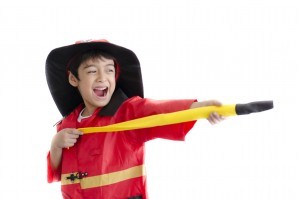How to Make Fire Safety Fun for Your Kids
by Debbie Goldberg 05/17/2018

A house fire is a parent and home owner's worst fear. Many people see tragic house fires as a case of very bad luck, but in reality most house fires can be avoided by practicing good fire safety.
To prevent house fires and to know what to do in case you have one, you'll need to learn and teach your children about the main causes of house fires, how to prevent them, and what to do when a fire occurs. We'll cover all of that in this article, plus give you some tips on making it easy and fun for kids to learn.
How do house fires happen?
The eight most common causes of house fires are:
- candles
- smoking
- electrical/lighting
- dryers and washing machines
- lightning
- kids playing with fire
- tree decorations
- kitchen/cooking
Play investigator
To prevent some of the causes of fire listed above, gather your children and put on your investigator hat. Make a checklist of the following and scour your house together to search for clues of fire hazards, taking care of them as you go along. Look for:
- Overloaded power strips and damaged power cords
- Dryer vents that are clogged up or dirty
- Stove burners that are near flammable items like curtains
- Smoke detectors checked
- Extra batteries located
- Escape route noted (see below)
- Ensure kids know the rules about candles, cooking, playing with fire, etc.
Plan your escape
Teaching kids a fire escape route can be tricky. It might get confusing for them or they might forget or panic in case of an actual fire. Therefore the best way to teach kids a fire escape plan is to practice it often.
Have monthly or bi-monthly fire safety checks with your kids and go over your escape plan and test your smoke detectors. Yearly, participate in fire safety week, which also covers escape plans and best practices but turns it into a weeklong series of activities you can do with your kids.
When it comes to the actual fire escape plan, grab some graphing paper and colored pencils and sit down with your kids to create your home.
Include in your plan the names and escape routes (2 minimum) of each room and the outdoor meeting place. Have kids draw their own (age appropriate) to help them understand the plan better and get them involved. Once you've drawn the plan, run through it a few times with your kids.
If you have infants or very young children who can't get themselves out of the house, plan who will retrieve them from their room in case of a fire. Remember to tell the kids not to wait for others before getting outside, and to not try to take belongings with them.
Stick to your routine
The hardest part about fire safety is making it a habit. At school, your kids have mandatory fire drills. At home, however, parents get busy with work or forget and tend to ignore fire safety. So, you'll have to find ways to make sure you and your family stick to the plan.
If you have a family calendar hanging in your home, make sure you pencil in your bi-monthly fire safety meeting. Similarly, anyone in your family who uses a calendar on their phone or computer should add it there as well and invite the other family members. Make sure the event is fun for everyone to ensure no one dreads it. You could make a plan to take the kids out to dinner or somewhere fun after to make it a night everyone looks forward to every couple of months.
 A house fire is a parent and home owner's worst fear. Many people see tragic house fires as a case of very bad luck, but in reality most house fires can be avoided by practicing good fire safety.
To prevent house fires and to know what to do in case you have one, you'll need to learn and teach your children about the main causes of house fires, how to prevent them, and what to do when a fire occurs. We'll cover all of that in this article, plus give you some tips on making it easy and fun for kids to learn.
A house fire is a parent and home owner's worst fear. Many people see tragic house fires as a case of very bad luck, but in reality most house fires can be avoided by practicing good fire safety.
To prevent house fires and to know what to do in case you have one, you'll need to learn and teach your children about the main causes of house fires, how to prevent them, and what to do when a fire occurs. We'll cover all of that in this article, plus give you some tips on making it easy and fun for kids to learn.
